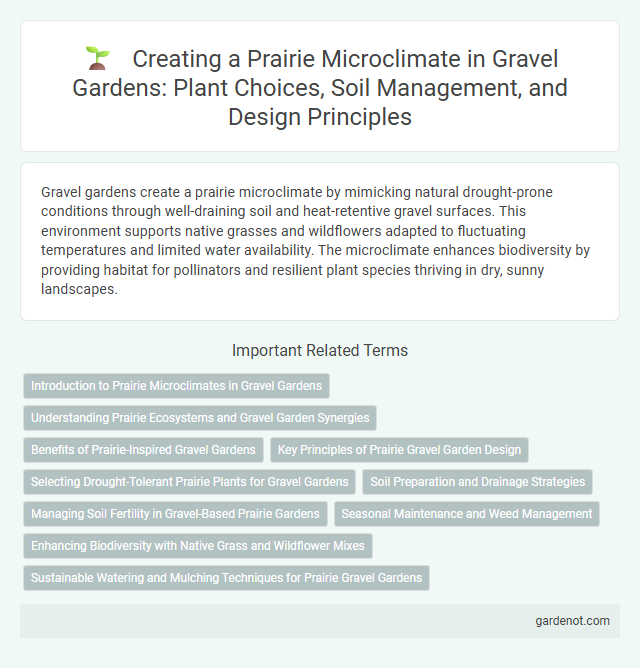Gravel gardens create a prairie microclimate by mimicking natural drought-prone conditions through well-draining soil and heat-retentive gravel surfaces. This environment supports native grasses and wildflowers adapted to fluctuating temperatures and limited water availability. The microclimate enhances biodiversity by providing habitat for pollinators and resilient plant species thriving in dry, sunny landscapes.
Introduction to Prairie Microclimates in Gravel Gardens
Prairie microclimates in gravel gardens create unique environmental conditions characterized by well-drained, nutrient-poor soils and fluctuating moisture levels. These microclimates support drought-tolerant native grasses and wildflowers adapted to extreme temperature variations and intense sunlight. Understanding prairie microclimates helps optimize plant selection and garden design for sustainable, low-maintenance gravel gardens that mimic natural prairie ecosystems.
Understanding Prairie Ecosystems and Gravel Garden Synergies
Prairie ecosystems thrive on well-drained soils, making gravel gardens an ideal environment to replicate these microclimates by promoting efficient water infiltration and aeration. The synergy between prairie plants and gravel substrates enhances biodiversity while reducing maintenance needs through natural drought resistance. Integrating native prairie species in gravel gardens supports pollinators and soil health, creating resilient, sustainable landscapes.
Benefits of Prairie-Inspired Gravel Gardens
Prairie-inspired gravel gardens create a resilient microclimate that conserves water while enhancing soil health and biodiversity. Their deep-rooted native plants reduce erosion and support pollinators, promoting a balanced ecosystem. This sustainable landscaping approach lowers maintenance needs and provides year-round visual interest.
Key Principles of Prairie Gravel Garden Design
Prairie gravel garden design prioritizes soil drainage, native plant selection, and sustainable water management to create a resilient microclimate. Incorporating deep-rooted prairie grasses and drought-tolerant wildflowers enhances soil structure and supports beneficial insect habitats. Strategic gravel placement reduces soil erosion and moderates temperature fluctuations, promoting long-term ecological balance.
Selecting Drought-Tolerant Prairie Plants for Gravel Gardens
Selecting drought-tolerant prairie plants for gravel gardens enhances resilience in microclimates characterized by low moisture and high sun exposure. Native species such as Purple Coneflower (Echinacea purpurea), Little Bluestem (Schizachyrium scoparium), and Black-eyed Susan (Rudbeckia hirta) thrive with minimal irrigation, reducing water demands while supporting local biodiversity. Incorporating these perennial grasses and wildflowers not only aligns with prairie microclimate conditions but also promotes sustainable landscaping practices.
Soil Preparation and Drainage Strategies
Soil preparation for a prairie microclimate within gravel gardens involves enhancing soil structure to promote deep root growth and moisture retention while ensuring rapid drainage. Incorporating organic matter and coarse sand improves soil aeration and mimics natural prairie conditions, preventing waterlogging in heavy clay soils. Strategic installation of sub-surface drainage systems supports efficient water runoff, maintaining optimal soil moisture balance crucial for prairie plant health.
Managing Soil Fertility in Gravel-Based Prairie Gardens
Managing soil fertility in gravel-based prairie gardens requires tailored nutrient strategies to accommodate well-drained, low-organic soils typical of microclimates. Incorporating organic matter such as compost or biochar improves soil structure and promotes beneficial microbial activity vital for native prairie species. Regular soil testing guides precise amendments, maintaining balanced nitrogen, phosphorus, and potassium levels to support vigorous plant growth despite the challenging gravel substrate.
Seasonal Maintenance and Weed Management
Seasonal maintenance in a prairie microclimate involves regular pruning, mulching, and monitoring soil moisture to support native grasses and wildflowers adapted to fluctuating temperatures and precipitation patterns. Effective weed management requires early identification and removal of invasive species, alongside the strategic use of mulch and selective herbicides to minimize competition and maintain plant diversity. Timely attention to these practices ensures the health and resilience of a gravel garden's prairie ecosystem throughout the year.
Enhancing Biodiversity with Native Grass and Wildflower Mixes
Prairie microclimates in gravel gardens create ideal conditions for native grass and wildflower mixes that boost biodiversity by supporting pollinators, birds, and beneficial insects. These native species adapt well to the well-drained, nutrient-poor soil typical of gravel beds, promoting resilient ecosystems. Incorporating diverse prairie plants enhances habitat complexity, soil health, and local wildlife populations in urban and suburban landscapes.
Sustainable Watering and Mulching Techniques for Prairie Gravel Gardens
Sustainable watering techniques in prairie gravel gardens emphasize deep, infrequent irrigation to encourage drought-resistant root systems, reducing water consumption significantly. Mulching with organic materials such as shredded bark or leaf litter preserves soil moisture, suppresses weeds, and enhances soil health by gradually decomposing and adding nutrients. This combination of strategic watering and mulching supports the prairie microclimate by maintaining stable soil temperatures and promoting resilient plant growth in gravel garden environments.
Prairie microclimate Infographic

 gardenot.com
gardenot.com